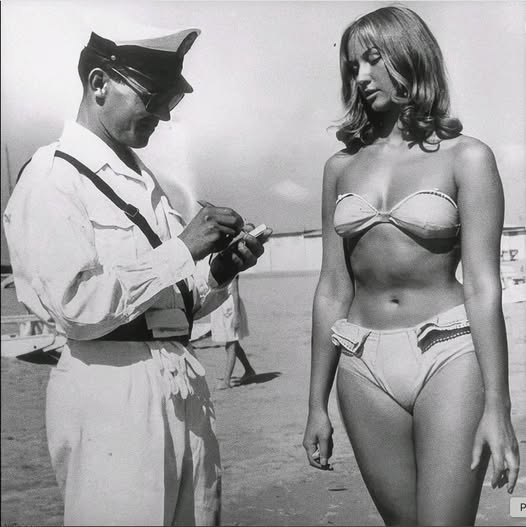At first glance, it might look like nothing more than a simple photo of a woman in a bikini on the beach. But look closer, and you’ll find layers of history woven into that carefree image—a story of controversy, defiance, and cultural change. That tiny garment once sparked outrage, was banned in multiple countries, and even led to arrests. Yet it also grew into a symbol of liberation, challenging ideas of morality and reshaping how society views women’s bodies and autonomy.
In the early 1900s, swimwear was designed for modesty, not comfort. Women wore heavy wool outfits that stretched from neck to knee, and many beaches in the United States enforced strict dress codes. Officials measured swimsuits for “compliance,” tailors stood by to add extra fabric, and even showing a bare knee was considered unacceptable.
The first wave of change came in 1907, when Australian swimmer Annette Kellerman donned a one-piece suit that exposed her arms, legs, and neck. Whether or not her reported arrest actually occurred, the act made international headlines. She soon launched her own line of swimwear, turning what women wore in the water into a declaration of personal choice.
By the 1920s, the flapper generation was rewriting social rules, and beachwear followed. Movements like California’s “skirts be hanged” campaign pushed for suits that prioritized movement and practicality over strict modesty. Little by little, functionality began to outweigh propriety.
Then came 1946, when French engineer Louis Réard unveiled the bikini—a daring two-piece that revealed the navel and far more skin than society was ready for. He named it after Bikini Atoll, where the U.S. had recently tested a nuclear bomb, boasting that its cultural impact would be just as explosive. He was right. The bikini was banned in multiple countries, denounced by the Pope, and declared immoral by conservative governments. In photos from the era, police can be seen issuing tickets or escorting women off beaches for “indecency.”
Through the 1950s and 60s, the pushback persisted. Hollywood’s Hays Code forbade exposed navels on screen, and moral watchdogs fought to keep the bikini out of the mainstream. But cultural icons refused to give in—Marilyn Monroe’s playful photo shoots, Brigitte Bardot’s effortless French Riviera style, and Ursula Andress’s unforgettable scene in Dr. No redefined the bikini as a global emblem of beauty, confidence, and female power.
By the 1970s, what was once scandalous had become standard. Bikinis got smaller, string styles appeared, and men’s swimwear became more revealing as well. What had begun as a battleground over women’s clothing had been transformed into a question of personal freedom.
Today, the conversation around swimwear is less about morality and more about self-expression. Whether it’s a modest one-piece, a sporty wetsuit, or the tiniest string bikini, the message is the same: wear what makes you feel confident, comfortable, and authentically yourself.
So when you see a woman lying in the sun in her bikini, it may seem like just another snapshot of summer. But behind that image is over a century of struggle—the fight for the right to be seen, to be free, and to choose, unapologetically, what to wear.
